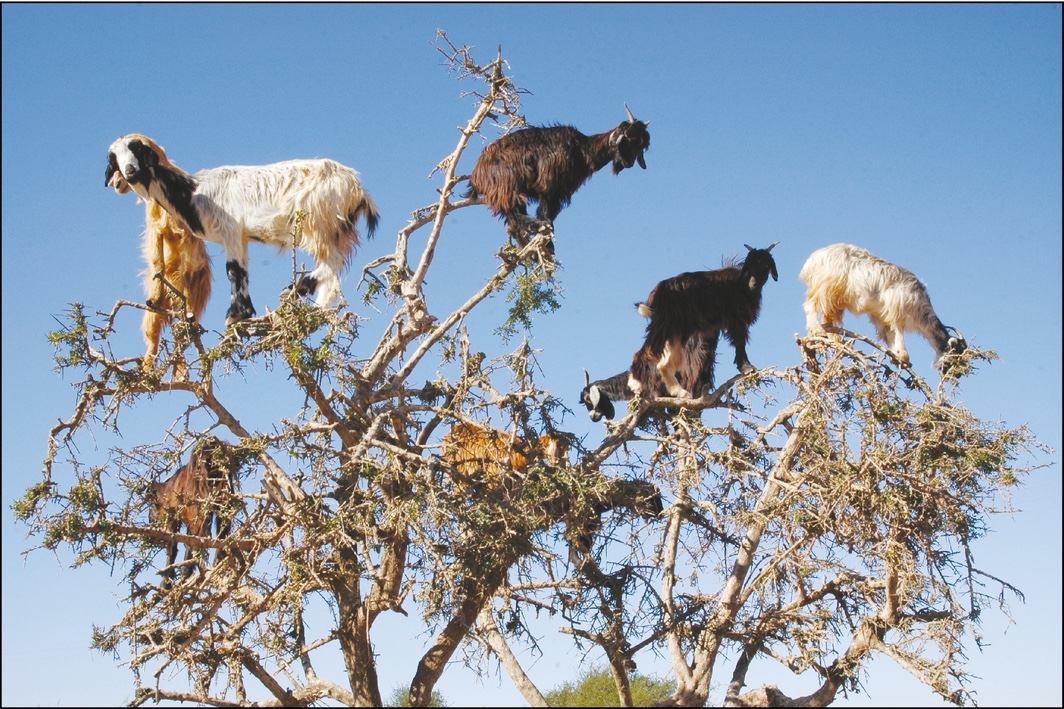Ptooey! Tree-Climbing Goats Spread Seeds by Spitting

Tree-climbing goats in Morocco give their roosts where they feed a boost … by spitting the trees' seeds on the ground.
Yes, Morocco has tree-climbing goats. Herders in the arid southern part of the country even encourage their domesticated goats to climb by pruning the thorny argan trees the animals love. Especially in autumn, when other vegetation is scarce, the fruit of the argan tree is an important source of calories for the goats.
The goats may be important for the trees as well. Researchers have now found that climbing goats consume the olive-like fruit of the argan tree and later spit out the nuts, they reported May 2 in the journal Frontiers in Ecology and the Environment. Other cud-chewing ruminant animals might do the same, the researchers wrote, meaning that regurgitation could be just as important as defecation for spreading some seeds. [Cats and Lizards and Monkeys, Oh My! 9 Islands Ruled by Animals]
Climbing goats
Study authors Miguel Delibes, Irene Castañeda and José M. Fedriani of the Doñana Biological Station in Seville, Spain, had previously seen goats in dry areas of Mexico and Spain climbing on short bushes and trees to graze. The goats in Morocco, though, tower above the competition — 10 to 20 at a time were regularly seen climbing argan trees between 26 and 33 feet tall (8 and 10 meters). [Video: Fainting Goats]
Plenty of argan seeds could be observed amid the spit-out cud and feces after the goats moved through, but it was impossible to tell whether the goats were regurgitating or defecating the seeds. Argan seeds are large, up to 0.8 inches (22 millimeters) in width, so it seemed unlikely they were moving through the entire digestive tract, the researchers wrote.
Spitting seeds
To show that regurgitation was the likely culprit, the researchers fed goats five different fruits with different size seeds. Almost any seed of any size could be spit out during rumination, or cud chewing, they found, but larger seeds were more frequently expectorated than smaller ones. Further testing found that 71 percent of ruminated, spat-out seeds were still viable.
The authors also reported seeing red deer and fallow deer as well as sheep spitting seeds while ruminating, suggesting that this behavior might be important for seed dispersal. Ruminants can keep their cud tucked away in their rumen, or first stomach, for days at a time, the researchers wrote, so a goat being herded long distances or making a seasonal migration could transport seeds for hundreds of miles.
Get the world’s most fascinating discoveries delivered straight to your inbox.
Original article on Live Science.

Stephanie Pappas is a contributing writer for Live Science, covering topics ranging from geoscience to archaeology to the human brain and behavior. She was previously a senior writer for Live Science but is now a freelancer based in Denver, Colorado, and regularly contributes to Scientific American and The Monitor, the monthly magazine of the American Psychological Association. Stephanie received a bachelor's degree in psychology from the University of South Carolina and a graduate certificate in science communication from the University of California, Santa Cruz.
